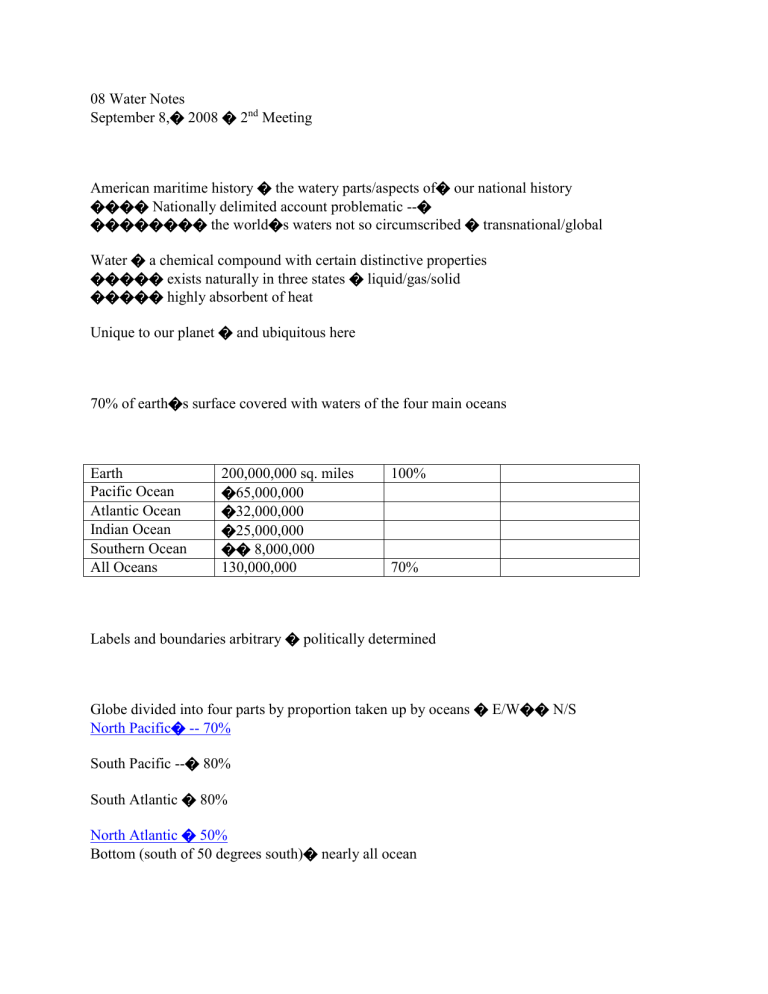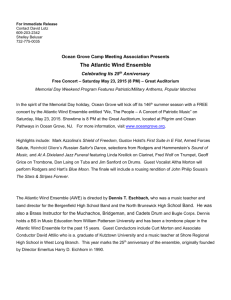Fall 08 Notes on Water II

08 Water Notes
September 8,
�
2008
�
2 nd
Meeting
American maritime history
�
the watery parts/aspects of
�
our national history
����
Nationally delimited account problematic --
�
��������
the world
� s waters not so circumscribed
�
transnational/global
Water
�
a chemical compound with certain distinctive properties
�����
exists naturally in three states
�
liquid/gas/solid
�����
highly absorbent of heat
Unique to our planet
�
and ubiquitous here
70% of earth
� s surface covered with waters of the four main oceans
Earth
Pacific Ocean
Atlantic Ocean
Indian Ocean
Southern Ocean
All Oceans
200,000,000 sq. miles
�
65,000,000
�
32,000,000
�
25,000,000
��
8,000,000
130,000,000
100%
70%
Labels and boundaries arbitrary
�
politically determined
Globe divided into four parts by proportion taken up by oceans
�
E/W
��
N/S
North Pacific
�
-- 70%
South Pacific --
�
80%
South Atlantic
�
80%
North Atlantic
�
50%
Bottom (south of 50 degrees south)
�
nearly all ocean
Ice caps --
������
Lakes and rivers
�
another couple %
�
[Great Lakes
Water in the atmosphere and under ground
Water in plants and animals
�
water content of humans
Nearly all of this water contains
� salt
� �
95%
� the watery planet
� �
continents as protusions
�
.
Initial focus of course on North Atlantic
�
the Atlantic world
�
(includes Med/Caribbean)
��
Pacific Ocean
������
Americans enter the Pacific only after the Revolution (1780s)
�������
Whalers 1810-1850s
�������
US acquires Pacific frontage in late 1840s --
�
Comparisons with Atlantic
�
bigger, wider, deeper, more placid
������ �
(less windy/currents less pronounced;
�������
has cooling impact on American west coast
�������
more mid-ocean islands
�
Less an arena for trans-oceanic exploration/settlement in 14 th -17 th centuries
���
Earlier
�
waterborne migrations of Polynesians to Australia/NZ/ Hawaii
���
China stops being a maritime power in 15 th
century
���
Japan and India not maritime expansionists in period
���
British and French into Pacific in 18 th
century
�
Cook in 1770s
����
���
Russians into Alaska
�
�
Indian Ocean
���
Region of considerable oceanic commerce/traffic by regional powers
�
Romans
���
Unique feature that facilitated travel
�
predictable seasonal reversal of wind patterns
��� � monsoon
�
--
�
winds out of southwest in summer; out of northeast in winter
��
Indian Ocean closed to Europeans until late 15 th
century
�
Portuguese around S. Africa
��
Americans into Indian Ocean on occasional late 18 th
-c slaving trip to Madagascar??
������
[Presently the principal locale of American Navy]
Southern Ocean
��
US Exploring Expedition in late 1830s
�
USS Vincennes
South Atlantic
��
On the way to somewhere else (Pawtucket)
��
Important to Portuguese in getting down and around Africa to Asia
������
and across to Brazil
��
American slavers to Guinea coast (Browns in 1750s)
��
Whalers sometimes down and around the horn into Pacific (not the Pequod)
��
China traders/ California hides ships (Dana
� s Acushnet) down SA east coast
North Atlantic
��
Competes with considerable land on either side and at top
��
Hour-glass shape
�
2000 mile neck Newfoundland
Irish coast
�������� ��������������������������
1800 mile waist between West Africa and Brazil
����������������������������������
4000 mile bust line
�
-- Mediterranean to Caribbean
���������������������������������������
Canaries to Bermuda --
�
3000 open sea miles
Seemingly easiest way to get from one side to the other
�
Over the top
���
Island-hopping: Norway
Faroes
Iceland
Greenland
Labrador
������
Newfoundland
short sail back
��������
St. Brendan/Vikings
�
./John Cabot/Henry Hudson
Sailors always looking back over their shoulders
�
Prefer to go out against the wind/current
� to make more likely a favorable wind back
�
What distinctive about the North Atlantic Ocean
�
and the crucial edge Europeans had
���
in happening upon the Americas --
�
a pronounced circulatory system
��� ocean currents
�
the long-range movement of ocean surface waters
����
determinants: prevailing wind patterns; earth
� s rotation; positioning of continents
���������
temperature/salinity
Coriolis Effect --
�����������
���
in NAtlantic -- two continuous loops
�
gyres
���
1. The NA Subtropical gyre
�
operates clockwise between 50
North Lat. and 20
North
�
��������
Eastern Limb
�
Canary Current
��������
Southern Limb
�
North Equatorial Current
��������
Western Limb
�
Gulf Stream
��������
Northern Limb
�
North Atlantic Current
�
��
2. NA Subpolar gyre --
�
operates north of the NA subtropical gyre (50 to 70
North)
����������
Southern and eastern limb
�
North Atlantic Current
����������
Northern Limb
�
Greenland Current
����������
Western Limb
�
Labrador Current
Prevailing winds
�
From Spain down to Canaries
�
from northeast
������������������������������
From Canaries to
Caribbean
�
from the east (
�
The Trades
�
)
������������������������������
From Caribbean up US coast
�
from the southwest
������������������������������
From Newfoundland to
Western Europe
�
from the west
Physical circumstances awaiting human initiative on the part of the physically advantage
�
------------------------------------------------------------------------------------
Local Waters of New York
New York coastal region
�
would include Long Island (1700 square miles; 120 miles long;
New York Harbor
�
includes
�
parts of
�
New Jersey -- 1500 square miles; 770 miles of shoreline
New York City
�
the 5 boroughs/4 of which are islands
�
400 square miles (65 of which under water)
����������
570 miles of shoreline
Manhattan
�
28 square miles
�
-- how many miles of shoreline??
Highly complex estuarine system
���
North Atlantic Ocean entering from the southeast through New York Bight
�
��������������
into Lower Harbor (between Sandy Hook and the Rockaways)
��������������
into Upper Harbor through the Narrows (between Staten
Island and Brooklyn)
��������������
also up the west side of Staten Island (Outerbridge Reach) into
Upper Harbor
�
Atlantic waters also entering from the top/west from Western Long Island Sound into East
River
�
Water also entering from upstate NY by way of Hudson River
�
Water also entering from Hudson via Harlem River to East River
NY water movement
�
Up/Down (Rise/Fall)
�
Tidal movement (in vertical feet in 6+ hour increments)
Flood/Ebb (in/out)
�
current movement (in knots in 6= hour increments)
NYC tides
�
4
�
swings
NYC tidal currents
�
3-4 knots at max ebb; maximum of 6 knots (East River ebb)
Twice-a-day flushing of the entire water system
Seldom freezes; not much subject to wave surges
One of the great natural harbors of the world
�
but now not supporting largest ships afloat
����
containers to New Jersey
�� �� supertankers off load off shore
NY Harbor waters a natural 18
�
depth --
�
dredging deeper channels for large/deep draft
� ships
Deep close in to shore line
�
makes docking possible
Ambrose Channel in 1890s
�
40
�
depth
�
Four
�
waterborne approaches to New York:
From north via Hudson River
From east via Western Long Island Sound
�
NOAA # 12363
From southwest via Arthur Kill
From southeast via the Narrows
West Quoddy to New York NOAA #13006
Approaches to New York
�
NOAA #12300
Lower Harbor NOAA # 12327
New York Upper Harbor
�
NOAA # 12334 (Narrows to Governors Island)
Lower Hudson and East Rivers
�
NOAA # 12402
Upper East River NOAA #
�
12339
Hudson River off Columbia campus
�
NOAA # 12341
Harlem River
�
NOAA # 12342





